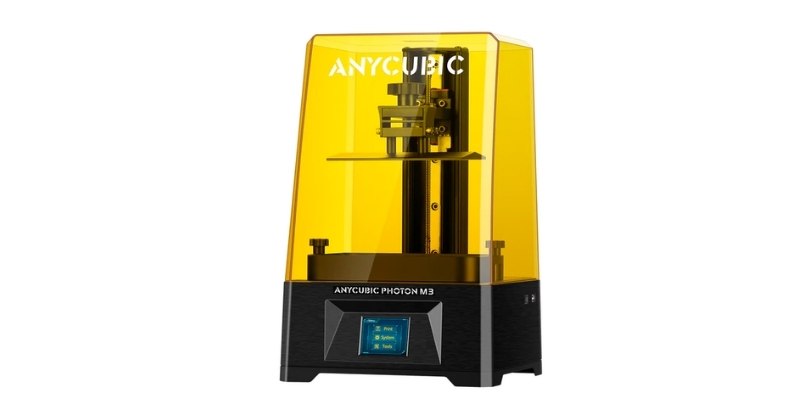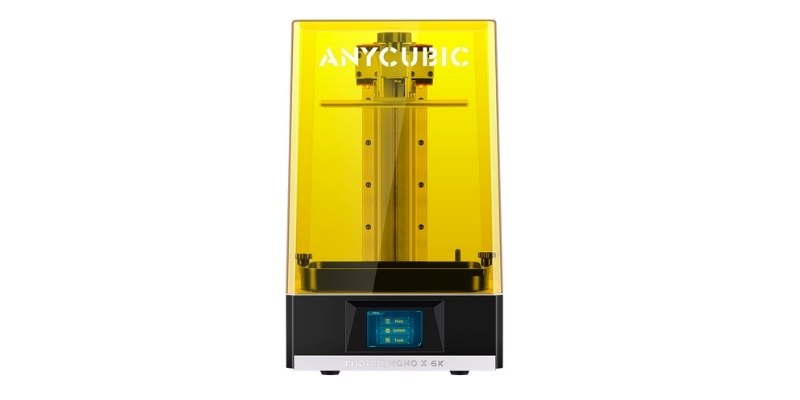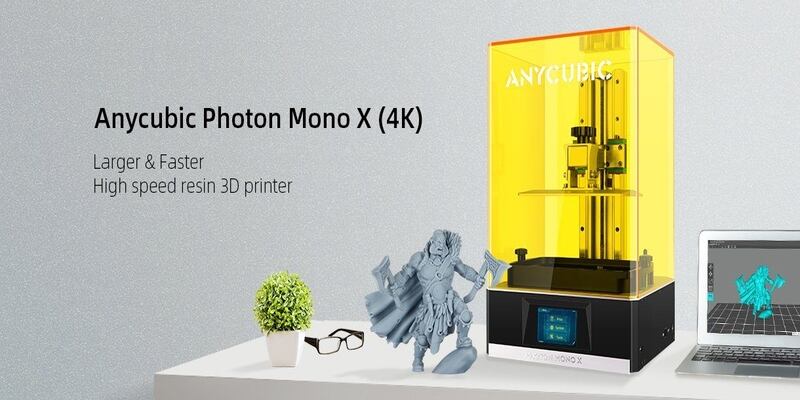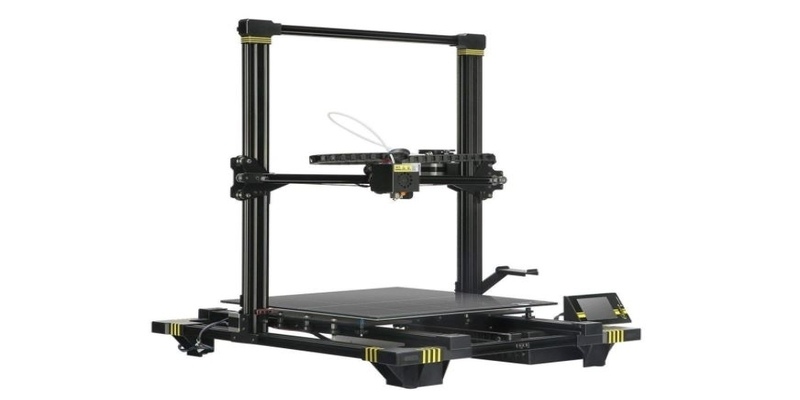
Anycubic is a well-known brand most known for selling some of the best low-cost resin 3D printers around, as well as some highly-rated FDM kits. We’d know, we’ve tested and reviewed most of them here on our site!
BUDGET PICK

Anycubic Photon M3
Available at:
MID-RANGE PICK

Anycubic Mono X 6K
Available at:
This article reviews the best Anycubic 3D printers for different budgets and projects – for example, if you’re looking to 3D print precise miniatures, go with an accurate resin printer like the Mono X, but for tougher projects or beginners, go with one of their FDM printers.
We’ll take a close look at the important features and functions of each machine, so you’ll easily be able to pick the one that best suits your needs.
3DSourced is reader-supported. When you buy through links on our site, we may earn an affiliate commission. Learn more
Best Anycubic Resin 3D Printers
Anycubic Photon Mono / Mono 4K – Best for Budget Resin Printing

Pros
Offers high quality at an affordable price.
Fast printing speeds for the price.
Highly precise machine.
Cons
Small printing size.
The Anycubic Photon Mono is a great little resin printer that offers high quality at an affordable price. It’s Anycubic’s cheapest and entry-level resin 3D printer, though you can choose to spend more on the Mono 4K, Mono X, or any of the other Mono 3D printers – you can read our Mono comparison here for more details.
If you’re unfamiliar with resin printing, it’s one of the two main 3D printing techniques alongside filament printing.
Resin printers cure resin layer-by-layer into solid objects using light, which makes it possible to achieve finer details in your models than FDM.
For those looking for a cheap resin printer, the Photon Mono is undoubtedly one of the best.
Among the highlights is the fast printing speed of up to 50mm/h, which Anycubic claims is 2.5x faster than other similar printers. It takes just 1.5 seconds per layer to cure resin, so it makes for speedier and more efficient printing than many budget models.
This Anycubic 3D printer doesn’t just offer speed, though. It’s also a highly precise machine, with a minimum layer height of 0.01mm – but you’ll probably never need to go that low.
This is achieved by the matrix parallel light source with 15 pcs lamp beads, which provides high uniform exposure and good heat dissipation, in combination with the Z-axis guide rail structure and stepper motor that offer great stability.
The high accuracy of this 3D printer means you’ll barely be able to see the layer lines on your prints.
The Photon Mono has a 5.11”x3.14”x6.49” printing size, so you can only use it for smaller projects, but it’s very compact and can easily fit in a home workshop.
It also uses a one-piece FEP film which is quick and easy to replace.
The Photon Mono range are known for being some of the best resin printers in their price range, with hundreds of positive reviews. If you don’t believe us personally, it has a 4.6-star rating on Amazon, and the forums rave about the accuracy for the price.
But for that next level quality, consider upgrading to the Mono X or Mono 6K, which we talk about next.
Read more about the Anycubic Photon series
Read more: Anycubic Photon Mono 4K and Photon M3 vs Elegoo Mars 3 compared
Anycubic Photon Mono X – Highest Quality Resin Printer

Pros
Very reliable.
Produces near-perfect results.
Beginners will find it easy to pick up.
Cons
Can be messy and will require regular cleaning.
An upgrade on the original Photon Mono, the Anycubic Photon Mono X is one of the most impressive resin 3D printers we’ve come across.
This model has several significant upgrades from its predecessor.
Firstly, it offers a significantly larger printing area of 7.55”x4.72”x9.84” in comparison to the Photon Mono’s 5.11”x3.14”x6.49”, allowing you to work on bigger projects. However, that’s far from the only improvement on the original Mono.
The Mono already offers fast printing speeds of up to 50mm/s, which is particularly good for a budget printer, but the Mono X ramps things up even more.
This model is capable of printing at up to 60mm/s, making it three times faster than standard resin printers. So if you’re a business owner in which production times are key, the Mono X can give you a big boost.
Another improvement is the upgraded matrix parallel UV light source with quartz lamp beads.
- Read more: Anycubic resin materials
This allows the printer to achieve more uniformity and 5% higher transmittance, with a super high resolution of 3840×2400 pixels, resulting in more accurate printing.
The Photon Mono X’s brushed aluminum platform greatly enhances the adhesion between the printer and platform, while the efficient UV cooling system achieves high levels of heat dissipation, increasing the tool life and reducing maintenance costs.
We also like how user-friendly the Mono X is to operate. It has a fully functional touch screen menu that makes it easy to control and monitor printing jobs, while the resin vat is marked so that you can accurately see how much resin is left at any time.
Finally, it’s also a really stable and sturdy printer. The double linear guide rail, screw motor and anti-backlash nut give the Z-axis fantastic stability and help to prevent printing layer lines.
If you like the sound of the Photon Mono X but don’t like the price so much, a cheaper option is the Photon Mono SE for $419.
While this doesn’t offer the same quality as the Mono X, it offers a larger, more durable LCD screen than the original Mono, in addition to a larger build volume and 4K resolution with 7% light transmittance for highly precise printing.
Best Anycubic FDM 3D printers
Anycubic Vyper – Best for Automatic Leveling
- Price: $429.99 — Check on Anycubic here

Pros
Can be built in under half an hour.
Comes with automatic leveling, which isn’t common in this price range.
Cons
Can be very noisy.
The Anycubic Vyper is a really impressive 3D printer that’s most notable for its automatic leveling. It’s one of several models on the market that offers this innovative feature, another popular option being the Creality 3D printer CR-6 SE.
This printer uses an intelligent leveling system that automatically adjusts the heat bed, offering two big advantages. We tested the Vyper a few months back, and were really impressed with it overall, especially the auto-leveling on such an affordable 3D printer.
This removes the time and effort of having to manually level the bed yourself, as well as removing human error from the leveling process and resulting in more accurate printing.
It’s also a very high-performance machine, largely thanks to the 32-bit motherboard and Cortex-M3 control chip which provide fast computing speed and smooth printing. The motherboard is silent thanks to the TMC2209 driver, which also delivers precise voltage output control.
Another interesting feature is the PEI spring steel magnetic platform. The spring steel coating of the platform helps ensure non-deformation at high temperatures and is scratch-resistant, and makes for easy model removal. You can use a wide variety of filaments with the platform, including PLA, ABS, PETG, and TPU.
It’s always important to ensure your 3D printer offers high levels of stability, and the Anycubic Vyper does just that.
It has a Z-axis double screw that runs synchronously, helping improve stability and reduce zeroing error. It can also automatically compensate for the difference of the hotbed to further increase the precision of Z-axis zeroing.
In terms of cooling, the Vyper uses a double fan two-way heat dissipation system.
Not only does this mean models cool rapidly, but it also allows you to achieve a higher printing speed than other printers while retaining the same quality – up to 100mm/s.
The Vyper isn’t Anycubic’s highest quality printer, so it may not be the best choice for more serious hobbyists or professionals, but it’s a fantastic choice for beginners and those who want to avoid manual bed leveling.
It has a small body but a decent printing size of 9.6”x9.6”x10.2”, so it can easily fit in a home workshop, and it has an intuitive 4.3” LCD control panel for simple operation.
Read more in our Anycubic Vyper review
Compare: Anycubic Vyper vs Kobra – compared
Anycubic Mega Pro – Best for Laser Engraving & 3D Printing
- Price: $399.99 — Check on Anycubic here

Pros
3D printer and laser engraver.
Comes with intelligent auxiliary leveling.
Excellent print quality.
Cons
The Touchscreen interface looks a little outdated.
The Anycubic Mega Pro isn’t your regular printer – far from it. This is one of the more innovative and versatile machines on the market, as well as being a 3D printer, it also doubles up as a laser engraver.
You can use the laser engraver attachment to work on a wide variety of materials, including wood, plastic, leather and paper.
This allows you to work on a whole range of different projects, from signs and home decorations to personalizing phone cases, keychains and much more. Whether you want to engrave your own printed models or work on other objects, the possibilities are endless.
On the printing side of things, one of the standout features of the Mega Pro is the intelligent auxiliary leveling. This automatically locates the leveling spot of the printing platform and makes it easier to precisely adjust the print head, making for both easier and more accurate printing.
This is an intelligent 210x210x205mm 3D printer with a smart filament interruption detection system.
This causes the printer to automatically pause if the filament runs out or becomes damaged. You can then resume printing with just one click once the issue is fixed, and the Mega Pro will still produce a complete model.
We’re also big fans of the high-strength dual gear extruder with optimized extrusion torque and path orientation.
This helps avoid uneven output, reduces the risk of nozzle clogging, and means the printer is capable of handling continuous, demanding printing jobs. The extruder is compatible with a variety of flexible filaments, such as TPU.
If you’re solely interested in 3D printing, you can probably find a higher-quality printer for a similar price.
However, if you want to both 3D print and laser engrave, then this is a fantastic machine that can do both at a lower cost than if you were to purchase two machines separately.
Anycubic Mega S – Great for Beginners

Pros
Good size for a good price.
Strong metal frame to minimize shaking.
Cons
The interface could be a lot better.
There are three versions in Anycubic’s Mega series, with the Pro being the middle one in terms of price.
If this model is out of your budget, the Mega S costs $259.99 and still offers high quality printing and the same print size, although it doesn’t offer laser engraving.
This is a neat little printer that can be assembled within minutes.
It has a strong, single metal frame that minimizes shaking, a high grade extruder for optimized filament feeding, and a heating integrated latticed printing platform with a patented microporous surface coating for strong adhesion and rapid heating.
Anycubic Mega X – Quality Printer for Serious Hobbyists

Pros
Large print space.
Uses a powerful Titan extruder, providing high torque to ensure smooth feeding.
Easy for a beginner to put together.
Cons
Can be relatively loud.
Alternatively, the Mega X is a more advanced machine that just offers 3D printing and not laser engraving.
This is the largest Anycubic printer in the Mega Series, with a print space of 11.81”x11.81”x12”, which means you can print larger models than 90% of other printers allow, according to Anycubic.
Another significant upgrade of the Mega X is the Y-axis dual sideway design and Z-axis dual screw rod design. These greatly improve the printer’s stability and in doing so make it possible to produce more precise models.
The rigid one-piece metal frame further helps to ensure rigidity while printing.
This Anycubic 3D printer uses a powerful Titan extruder, which provides high torque to ensure smooth feeding. It also helps prevent jamming and is compatible with various flexible filaments, from PLA and ABS to TPU, PETG and HIPS.
We also like the intuitive assembly and operation of this model.
The modular design makes it easy to put together even if you’re a beginner, while the large leveling knob makes it easier to level the platform. In fact, Anycubic claims it reduces leveling effort by as much as 60%.
Anycubic Chiron – Best For Large Models

Pros
Good size for the price.
Quick and simple to assemble out of the box.
Fast heating bed.
Cons
No automatic bed leveling.
If you’re looking for a 3D printer that allows you to print bigger and better models, make sure you check out Anycubic’s Chiron.
This printer offers a seriously impressive printing size of 15.75”15.75”x17x72”, which is significantly larger than most other models within this price range.
However, while it’s one of the larger 3D printers out there, that doesn’t mean it’s overly bulky or difficult to set up.
In fact, the Chiron has a modular design, so it’s very quick and simple to assemble out of the box.
This model also has several features that make it a highly intuitive printer to operate. For example, it offers semi-automatic leveling where the printer can automatically detect 25 points and support nozzle height adjustment and automatic compensation.
While this doesn’t quite make things as easy as the Viper’s auto-leveling feature, it’s the next best thing.
The Anycubic Chiron also boasts a Y axis dual sideway alongside a double Z axis. These help calibrate the machine before printing, greatly improving precision.
On top of that, the photoelectric limit switch helps improve the stability and flatness of the platform.
There are also some of the great features that are common to many of Anycubic’s finest models, such as automatic power off if there’s an accident and one-click printing resume, as well as a high-strength extruder compatible with a number of different filaments.
For a more detailed comparison, we have compared the Anycubic Chiron vs the Mega S, Mega X, Mega SE, and Mega Pro.
Articles we recommend:
- Elegoo Saturn vs Anycubic Photon Mono X
- Elegoo vs Anycubic resins
- Anycubic M3 vs Anycubic M3 Plus vs Anycubic M3 Max
- Anycubic Photon M3 vs Mono 4K vs Mono X/6K
- Anycubic Kobra vs Plus vs Max
- Anycubic Kobra review
- Best Prusa 3D Printers
- Best Flashforge 3D printers
- Best Flsun 3D printers
- Best Elegoo 3D printers




